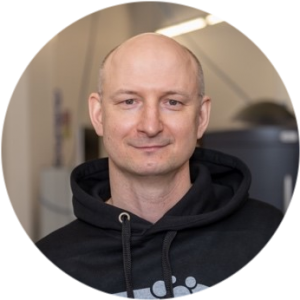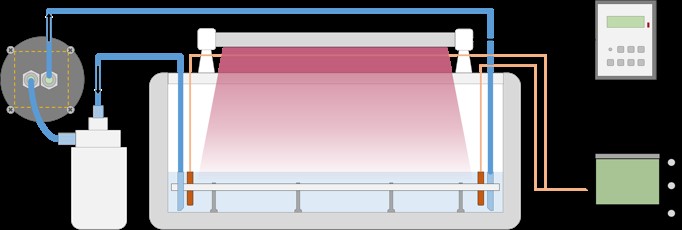 |
Professor Albert Nasibulin specializes in the aerosol synthesis of nanomaterials (nanoparticles, carbon nanotubes and tetrapods), investigation of their growth mechanism and their applications. At the moment his main recent research topic is devoted to transparent, flexible, stretchable and conductive single-walled CNT films and their applications.Solar sells on heterojunctions CNT/silica
| Details |
The efficiency of 1.5% obtained by us for this kind of a structure is state of the art till date [(1.) Solid State Commun. 150 561–3, (2) Appl. Phys. Lett. 98 183113]. |
| Objectives for 2016 |
- Optimization of interface between CNT/a-Si layers, and device architecture for higher conversion efficiency.
- Fabrication of SWCNT/a-Si heterostructures.
- Extending SWCNT as front contact replacing the traditional TCO/metal owing to its very promising opto-electrical properties.
- Preparation and paper publication of the research results in an international scientific journal indexed in the Scopus data base, or in “WEB of science”.
|
| Results/current status |
The current status is as follows:
- Dry and chemical etching of thick native oxide layer on a-Si. Surface treatment of a-Si.
- Interface engineering between a-Si and SWCNT for optimizing the energy levels.
- Doping of SWCNT for higher conductivity retaining the transparency.
- Modifying SWCNT for exploring the possibility to replace traditional metal grids as front contacts.
|
| Team and Collaborations |
|
| External funding |
H2020 program – ERA-NET |
| Publications by team members related to the project and with the Skoltech affiliations |
Adinath M. Funde, Albert G. Nasibulin, Hashmi Gufran Syed, Anton S. Anisimov, Alexey Tsapenko, Peter Lund, J. D. Santos, I. Torres, J. J. Gandía, J. Cárabe, and A. D. Rozenberg, Igor A. Levitsky (2016) Carbon nanotube – amorphous silicon hybrid solar cell with improved conversion efficiency. Nanotechnology. 27(18) 185401 (6pp) |
| Potential Impact |
The efficiency of 1.5% obtained by us for this kind of a structure is state of the art till date [(1.) Solid State Commun. 150 561–3, (2) Appl. Phys. Lett. 98 183113]. The fabrication of the proposed solar cell partially eliminates the complex, expensive vacuum techniques and replace with very simple dry transfer technique [ACS Nano 5 3214–21] of high quality pristine SWCNT. Moreover, these SWCNT owing to its opto-electrical properties are very promising to replace the conventional TCO/ITO as front and back contacts. This leads the way to extending CNT for exploring the possibility of an ‘All Carbon solar cell’. Thus, making the structure very economical, environmentally stable and less hazardous. |
Artificial nose on the basis of CNT matrix
| Details |
Development of high-precision compact gas sensor based on carbon nanotubes using the features of artificial neural networks for processing signals from various gas mixtures with different concentrations. The main idea based on the fact that pristine and chemically processed carbon nanotubes (CNT:) are very sensitive to different gas concentrations. The electrical properties of these structures strongly depend on the surrounding atmosphere. The artificial neural networks are proposed to be used for processing combination of electrical signals from CNT sensors treated in a different way. |
| Objectives for 2016 |
- Start experiments on electrical engineering and chemical treatment of carbon nanotubes.
- Launch of equipment and start measurements.
|
| Results/current status |
In progress (starts in the end of 2016), funded by Skoltech. Under going search and hire of a postdoc and PhD stidents. Almost all of the necessary equipment has already been purchased: gas distribution system for creation of different gas mixtures, temperature controlled stage Linkam for electrical measurements in different temperatures and surrounding gases, commutator Keysight. Purchasing of plasma treater for CNT processing is planned in the nearest future. |
| Team and Collaborations |
- Albert Nasibulin (PI);
- Postdoc (electrical engineering, general management) – to be hired;
- Ph.D. student (chemical processing);
- MS Student (experiments for neural network learning)
|
| External funding |
Additional funding provided to Res3arch package |
| Publications by team members related to the project and with the Skoltech affiliations |
Not yet |
| Potential Impact |
Artificial nose is very promising technology which can be applied in different R&D and technical areas such as quality control (detection of contamination and spoilage; monitoring of storage conditions), process and production (comparison with a reference product, measurement and comparison of the effects of manufacturing process on product, scale-up monitoring), health and security (quality control of food products, detection of dangerous and harmful contamination, detect odourless chemicals) etc. |
|
|
Stretchable electronic components based on nanomaterials
| Details |
Developed a prototype of transparent supercapacitor with a specific capacitance of 17.5 F g-1, which can be stretched up to 120% with practically no variation in the electrochemical performance after 1000 stretching cycles and 1000 charging-discharging cycles. |
| Objectives for 2016 |
- Develop working prototype of stretchable device based on piezo-generator film (PVDF) and supercapacitors.
- Study of optical, electrical and mechanical properties of stretchable electrodes made of CNT films.
- Apply to STRIP Skoltech contest 2016 with the project on piezo-supercap device.
- Patent submission on piezo-supercap device.
|
| Results/current status |
- Almost in progress (in 2015).
- All the necessary equipment is purchased and delivered (tensile testing mechanical device, tensile stage for SEM measurements and investigation), delivery of Test Cell (Japan) by the end of 2016 is expected.
- STRIP proposal was submitted in 2015 and passed to a final stage of the contest, proposal was one of the finalist of “Green Chip” contest by ROSNANO.
|
| Team@Collaborations |
Albert Nasibulin (Principal Inviestigator)Team:
- Evgenia Gilshteyn,
- Daler Amanbaev,
- Vladislav Tkachuk;
Collaborators:
- Tania Kallio, Research Group of Electrochemical Energy Conversion and Storage, Department of Chemistry, School of Chemical Technology, Aalto University;
- Ekaterina Fedorovskaya, Nikolaev Institute of Inorganic Chemistry Siberian Branch of Russian Academy of Sciences;
- Maxim Silibin, MIET (National Research University of Electronic Technology).
|
| External funding |
N/A |
| Publications by team members related to the project and with the Skoltech affiliations |
Evgenia P. Gilshteyn, Tanja Kallio, Petri Kanninen, Ekaterina Fedorovskaya, Anton S. Anisimov, Albert G. Nasibulin (2016) Stretchable and transparent supercapacitors based on aerosol synthesized single-walled carbon nanotube films. RSC Advances 2016, Accepted Manuscript DOI: 10.1039/C6RA20319A |
| Potential Impact |
Transparent energy conversion and storage devices have recently attracted increasing attention due to their great potential as integrated power sources for displays and windows in buildings, automobiles and aerospace vehicles. On the other hand, mechanical stretchability coupled with optical transparency of the energy storage devices is required for many other applications, ranging from self-powered rolled-up displays to self-powered wearable optoelectronics. The design of highly stretchable devices is an essential element in the development of many unprecedented applications such as electronic skin and smart energy storage clothes. Portable and wearable supercapacitors, coupled with either self-healability or stretchability, have particularly become a mainstream in the personalized electronics. In addition, aerosol synthesized and collected on a filter SWCNTs can be effectively transferred to any substrate, including stretchable substrate materials such as PDMS (polydimethylsiloxane). They fulfil all the requirements for low-cost, stretchable and transparent electronics. |
|
|
Ultrasound generation using free-standing carbon nanotube films
| Details |
The primary goal of the project is to do a research with Single-walled carbon nanotubes (SWCNT) as a flexible, transparent, powerful, flat amplitude-frequency response transducer of ultrasound. |
| Objectives for 2016 |
Complete research of SWCNT ultrasound transducers in the gas mediums (frequency range 10Hz – 100 kHz), find the potential customers for the ultrasound based SWCNT transducers and make prototypes for them. Write an article covering current research results. |
| Results/current status |
The first series of experiments of SWCNT transducers in the range of 10 Hz – 100 kHz in the air was successfully arranged with qualitative and quantitative results. Currently, we are waiting for equipment to make new series of measurements in different gases and liquids mediums. |
| Team@Collaborations |
Stepan Romanov, Daria Kopylova |
| External funding |
N/A |
| Publications by team members related to the project and with the Skoltech affiliations |
Stepan Romanov, Single-walled carbon nanotubes as a source of ultrasound, Skoltech Master thesis diploma 06.2016. |
| Potential Impact |
In general, the technology is applicable in any field which uses ultrasound (Medicine, Industry, Science.). The main advantages of SWCNT-based transducers are: flexibility (allow to easily make focused ultrasound), organic material, production easily scalable, the transducer have a flat amplitude-frequency response dependence and large bandwidth. |
|
|
Synthesis of single wall nanotubes with controlled chirality
| Details |
Installation of the reactors |
| Objectives for 2016 |
- Optimization of hydrocarbon based process for high yield synthesis of SWCNT using spark discharge generator like catalyst source.
- Using two chambers reactor for annealing of metallic CNTs in aerosol state.
- Influence study of catalytic NPs on CNTs diameter distribution.
|
| Results/current status |
Development of reactor design;Assembling of experimental setup/In progress;Synthesis process optimization /In progress. |
| Team and Collaborations |
N/A |
| External funding |
N/A |
| Publications by team members related to the project and with the Skoltech affiliations |
N/A |
| Potential Impact |
One step synthesis of selected chirality/ narrow diameter distribution of CNTs; Possibility to get long unicherality CNTs. |
Doping of the single wall nanotubes for improvement of transparent electronic devices
| Details |
Demonstrated technology for fabrication of state of the art transparent (90%) conductive films with 50 Ohm/sq. |
| Objectives for 2016 |
- «Acids» treatment of CNT films for increasing transparency by removing iron catalytic nanoparticles;
- Selection of dopants and solvents. Optimization of doping solution concentration.
|
| Results/current status |
- Three best reagents for removing iron nanoparticles have been found in set of 10 different solutions. Like result we got increasing of transparency on 1-1.5% for 90% T samples;
- Set of different P- type dopants like Re-salts, Pt-salts, Au-salts in different solvents has been used. Work on methods of covering dopants onto sample surface /In progress
- Development of list potential N-type dopants/ In progress.
|
| Team and Collaborations |
N/A |
| External funding |
N/A |
| Publications by team members related to the project and with the Skoltech affiliations |
Article submission about doping effect of p-type dopants in different solvents / in progress. |
| Potential Impact |
Potentially open opportunity of development p-n junction devises on SWCNT films; Increasing quality factor of transparent electrodes for various applications. |
|











